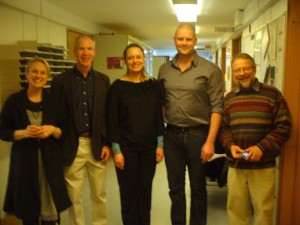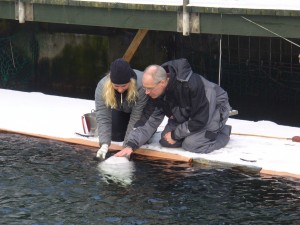Professor Alex Werth spent a week (Jan 24-29, 2011) with fellow marine biologists at Aarhus University in Denmark (www.au.dk/en) to study whales. Dr. Werth served as an “opponent” or member of the thesis committee of Aarhus PhD student Malene Juul Simon, whose doctoral dissertation was on “Baleen whales, their foraging behavior, ecology and habitat use in an arctic habitat.” Specifically, she studied the feeding and migration of bowhead, humpback, and other whales in the waters around Greenland, where she lives. Dr. Werth had to attend her thesis defense—she passed and earned her PhD—as well as to present his own research findings in a symposium/workshop with many Scandinavian whale researchers. After the thesis defense Dr. Simon’s family hosted a reception with tasty Danish and Greenlandic food, including musk ox and reindeer along with many kinds of fish.

Dr. Werth also spent time with his colleague (and Simon’s graduate adviser) Dr. Peter Teglberg Madsen at the Fjord & Baelt marine research facility in Kerteminde, Denmark. With Polish PhD student Danuta Wisniewska and other graduate students they are studying feeding in harbor porpoises (Phocoena phocoena) and harbor seals (Phoca vitulina). The goal is to see how they use suction, generated by rapid depression and retraction of the tongue, to suck in water and ingest fish. This is investigated using digital tags (temporarily affixed by suction cups to the animals) which include hydrophones, accelerometers, and other sensors. High speed cameras show what the animals are doing at the same time that the tags record digital data about the animals’ movements, sounds, and muscular contractions. The harbor porpoises had to be trained to accept a small sensor on their throats along with the main tag on their backs, so Professor Werth worked with the trainers to get the animals to roll over and be tagged. This work will continue, and he hopes to return when Denmark is not as cold and snowy!


